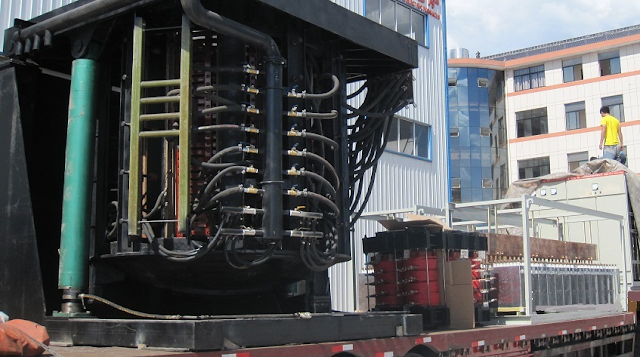Troubleshooting of Medium Frequency Furnace
This article introduces the faults and solutions of medium frequency furnace.
1. Fault phenomenon: large DC current, low DC voltage, and if the voltage, dull equipment sound, over-current protection.
Analysis and treatment: the thyristor with one arm of the inverter bridge may be short-circuited or open-circuited, resulting in the operation of the three-arm inverter bridge. Use an oscilloscope to observe the voltage drop waveform of the thyristor on the four bridge arms of the inverter bridge. If the voltage drop waveform of the thyristor on one bridge arm is a line, the thyristor has been through; if it is a sine wave, the thyristor has not been through. Replace the through thyristor; find out the reason why the thyristor is not turned on.
2. Fault phenomenon: when the heavy load cold furnace is started, all electrical parameters and sounds are normal, but the power cannot be raised, and overcurrent protection.
Analysis and treatment:
(1) the angle of the inverter is too small. Use an oscilloscope to watch the converter angle of the inverter thyristor, and adjust the converter angle to the appropriate value.
(2) The insulation resistance of the furnace body is low or short-circuited. Megger is used to detect the resistance value of the furnace body and eliminate the short circuit point of the furnace body.
(3) The resistance of charge (steel) to the induction coil is low. Use a megger to check the resistance of the charge relative to the induction ring. If the resistance is low, rebuild the furnace.
3. Fault phenomenon: when starting, the DC current is large, the DC voltage is low, and the intermediate frequency voltage cannot be established normally.
Analysis and treatment: compensation capacitance short circuit. Disconnect the capacitance and use a multimeter to find the short-circuit capacitance. Replace the short circuit capacitor.
4. Fault phenomenon: the starting circuit of zero voltage other excitation (without special signal source) is not easy to start.
Analysis and treatment:
(1) the current negative feedback is not adjusted properly.
(2) Whether the reverse parallel diode in series with the current transformer breaks down.
(3) Whether the signal wire is too long or too thin.
(4) Whether the signal synthesis phase is connected wrongly.
(5) If the intermediate frequency transformer and isolation transformer are damaged, pay special attention to the transformer turn to turn short circuit. Readjust the current negative feedback; replace the damaged parts.
5. Fault phenomenon: when starting, all electrical parameters and sound are normal. When the power is increased, the current suddenly fails. When the voltage reaches the rated value, the over-voltage and over-current protection will be provided.
Analysis and treatment: load open circuit, check the load copper bar connector, and water-cooling cable.
6. Fault phenomenon: it is difficult to start the zero voltage other excitation frequency starting circuit.
Analysis and processing:
(1) the selection of sweep starting frequency is not appropriate, and the starting frequency is selected again.
(2) The sweep circuit is faulty. Use an oscilloscope to observe the waveform and frequency of the sweep circuit. Troubleshoot the sweep circuit.
Free send inquiry to stella@hanrm.com if any needs.
Whatsapp/Wechat:+8615877652925
Website: https://www.hanrm.com
More News You May Interesting:
What is Induction Furnace?
How does a Blast Furnace Work?
Significance of Reheating Furnace Technology in Rolling Reheating Furnace
Why Use Coke for Blast Furnace Ironmaking does not Use Coal Directly?
How to Improve the Thermal Efficiency of the Reheating Furnaces?
What is the Reheating Furnace Temperature System?
Advantages of Walking Beam Reheating Furnace
Walking Beam Reheating Furnace
The Development Trends and Advantages of Electric Arc Furnaces
The Advantage of Induction Furnace ( Medium Frequency Furnace)



评论
发表评论